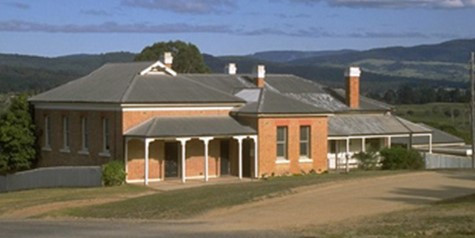South Coast NSW History Story
The Old Pambula Court House and Police Station
The Old Pambula Court House, Police Station and adjacent cell block in Toallo Street are the oldest complex of publicly accessible buildings in Pambula.
They are historically important because they reflect the early European history of the district, they are a reminder of the development of the region as a centre for law and order administration, and they illustrate periods of growth and contraction in the local district’s population and wealth.
They are now a particularly significant part of Pambula’s historic townscape, being prominently sited on the hillside overlooking the dairy flats and flood plain below.
The materials used in their construction (predominantly bricks, timber and sandstone) were locally sourced, providing an example of resources that were available in the district.
There are four distinct but connected parts in the complex – a court house, a police station, a police residence and a cell block. These were constructed or altered on a number of occasions, with the most significant construction phases being in 1861, 1895 and 1897 – so the buildings and their uses are not indicative of just a single period of time in the town’s history.
But the numerous stories relating to their construction are interesting.
Originally the administration of justice in Pambula was the responsibility of the Eden police district which covered the whole of the County of Auckland (from the Victorian border in the south to the Brogo River in the north). But, following the surveying and emergence of the ‘Panboola’ township in the late 1840s or early 1850s, police were stationed at this local outpost.
In 1856 (by which time there were 5 hotels operating in Pambula), £100 was made available for the erection of a lock-up in the town and in 1858 a Court of Petty Sessions was established. A year later the lock-up was completed – but only after Police Magistrate Keon of Eden first had to write to the Secretary of Lands and Public Works complaining that ‘the sum of £100 has been granted for some time…nothing has yet been done’ and, when it was completed, it was realized that a man would need to be employed to oversee it, and that accommodation was needed to house him!
That original structure (plus an added-on room for the lock-up keeper) was demolished the following year. In December 1860 a foundation stone for a new court house and watchhouse was laid by two local citizens, Peter O’Neil and Syms Covington. The buildings – which were described as ‘built after the government model of ugliness’ - were completed in September 1861.
But the ‘government model of ugliness’ was not the complex’s only shortcoming. During construction Police Magistrate Murray wrote that ‘the present structure consists of two cells and a constable’s room and sleeping room. It occurs to me that it would be advantageous to turn one of the constable’s rooms into a cell, making three cells…the Lockup keeper could use the (additional) cell as a sleeping room…(and) in the event of a person being apprehended for a serious offense than a vagrant or perhaps a female all at the same time, there would not be convenience for them on the present plan’. And, when the building was completed, Police Magistrate Murray and Justices of the Peace John Lloyd and J H Bennett were again noting that no chains or padlocks had been supplied for the cell doors, ‘only the usual gaol bolts’,…and that fencing and water tanks were needed!
In 1894 the condition of the gaol attracted the attention of the local press: ‘The wall, which is only about 7 foot high and could be scaled with ease by any person of average height, was erected over 30 years ago. It was made of hardwood and judging by its appearance has never been repaired since its erection. The timber is completely rotten, and some weeks ago a portion of the northern wall was blown over by the wind and broke in pieces…the doors of the yard are so warped and shrunken that they cannot be closed. The walls can be swayed to and fro by a strong push with the hand…Prisoners cannot be allowed in the yard unless an officer is constantly at their side to prevent their escape.’
In 1895 a separate brick gaol with two cells ‘fastened with massive bolts and locks’ was built and extensive renovations and additions were made to the police residence, which was converted from only being suitable for a single man to one providing comfortable accommodation to a married man and his family.
One month later, shortcomings within the Court House were obvious so further additions and alterations to the complex were undertaken which resulted in a new Courtroom being added and the original building being converted for use as a police station and residence. In the 1930s further renovations were undertaken to the courthouse.
The lock-up was used until 1978 and the police station was used until 1979, at which point it was converted to a residence for police stationed in Merimbula. The courthouse continued to be used every week as a Court of Petty Sessions until 1984. The government then proposed to sell the property, but in 1992 leased the building to the Bega Valley Genealogical Society, which still operates from the building. In 1994 the Bega Valley Shire Council became trustee of the building.
Sources: NSW State Heritage Inventory (at www.environment.nsw.gov.au/heritageapp/heritagesearch.aspx); Bega Valley Genealogical Society.
